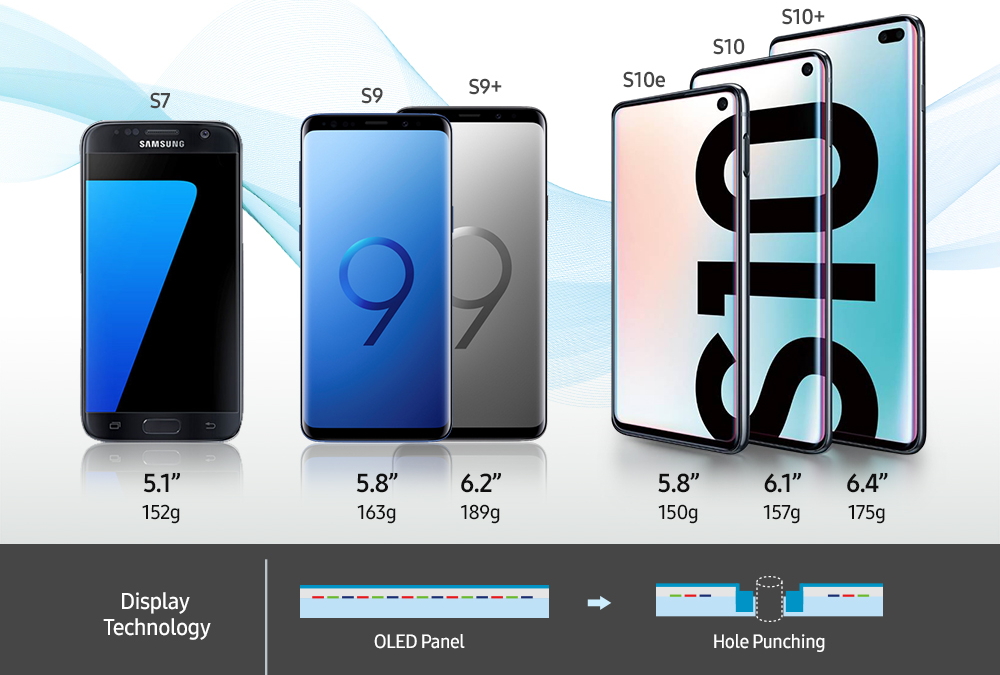[Interview] Infinity Viewing Experience: Behind the Galaxy S10 Display
on March 19, 2019
It has been over 10 years since Samsung Electronics first fitted an AMOLED display on its Haptic AMOLED phone in 2009 and on Galaxy S products in 2010. With the latest additions to the flagship Galaxy range, the Galaxy S10 line, the AMOLED display has evolved to provide crystal-clear picture quality and a display size that is 1.5 times bigger compared to the Galaxy S.
Thanks to these cutting-edge developments, the Galaxy S10 line offers a display with a brilliant, realistic picture quality whilst being comfortable on the user’s eyes and able to reflect various color preferences. Samsung Newsroom sat down with Byungduk Yang, Vice President of Samsung Electronics’ Mobile Communications Division to learn more about how the Galaxy S10 line’s display is at the core of the user’s mobile experience.
A User-Friendly Approach to Display Technology
Yang’s development philosophy for mobile displays puts the user first; “providing practical screen solutions and new experiences have become our core values,” explained Yang. “As a result, the Galaxy S10 line’s display focuses on providing interesting experiences and real-life benefits to users, beyond just good picture quality or display size.”

Of course, one of the key innovations of the Galaxy S10 line is the full screen experience provided by the ‘Infinity-O Display’ that covers, bar the camera, the entire front side of the device. In order to seamlessly integrate the front camera into the display, a small and precise hole is made in the screen using a delicate laser cutting technique and advanced barrier technology. These procedures maximize screen real estate, enhancing the reliability of barrier performance of AMOLED pixels around the hole. Therefore, users’ visual experience is maintained, or even more improved on the Infinity-O Display along with Dynamic AMOLED technology at the highest quality possible. “The Galaxy S10 line’s full display offers picture quality that is more realistic than before,” noted Yang.
But the Galaxy S10 line’s display provides real-life benefits and experiences to users beyond just high picture quality. “We wanted to achieve a ‘user-friendly’ display,” explained Yang. “Display-based devices are known to harm users’ retinas after prolonged use to due blue light emissions. This is particularly a problem at night, when exposure to blue light inhibits melatonin production which can affect sleep patterns. But the Galaxy S10 line’s display delicately manipulates the wavelength of blue OLED to remove the harmful energy, which means the device can be used for a long time with minimal damage to the user’s eyes.”
Previously, smartphone displays used regular software to reduce the amount of blue light emanating from the display. But the Galaxy S10 line harnesses a technology that reduces blue light exposure by 42% more than the previous technique, without compromising picture quality. “We have even received an Eye Comfort Certification from TÜV Rheinland,” enthused Yang. “Users will definitely notice than their eyes are less strained when using the Galaxy S10.”
Changing the Way We See Color

Key to the brilliant realism of the Galaxy S10 line’s Dynamic AMOLED display is its evolved color representation. Compared to previous Galaxy phones, the Galaxy S10 line is the most exceptional yet; DisplayMate’s Just Noticeable Color Difference (JNCD) unit measurement for Galaxy S10 is 0.4 JNCD (where the lower the value, the more realistic a color rendering is), up from the Galaxy Note 9 and Galaxy S9’s ratings at 0.5 and 0.7 JNCD respectively.
This near-perfect color rendering also takes into account global user color preferences. “We identified that people read color differently depending on where they are from, their age, and their gender,” explained Yang. “To accommodate this, we asked over 2,000 people in 15 countries all around the world to provide their color preferences. We then analyzed their responses and, given the results, created two default color modes. ‘Natural Mode’ has a warmer tone to suit people in the US and Europe, whereas ‘Vivid Mode’ accents bluish tones for users in Asia.”
A Display to Match the Human Eye
On top of being able to render over 16 million colors, the Galaxy S10 line’s Dynamic AMOLED Display also supports high definition, providing the user with optimized high picture quality for every image, and as the world’s first smartphone display to support HDR10+, for every frame of a video, as well. Much like how the pupils in our eyes dilate and contract depending on the amount of light around us, the Galaxy S10’s display features Dynamic Tone Mapping technology that adjusts and optimizes picture quality according to the light-dark contrast on the screen.
The display has also received a ‘100% Mobile Color Volume’ certification for its realistic image rendering – the first smartphone range to ever do so. In order to achieve such display prowess, not only has Samsung been tirelessly working on AMOLED organic material research, but also on its proprietary picture quality engine, ‘mDNIe (Mobile Digital Natural Image Engine)’.
So what is the future of device display, as envisaged by Yang? “In the past, we began with black and white displays – TV screens – and the natural next step was to develop displays that presented images in color, moving closer to how we, as humans, perceive the world. Accordingly, we are to take this verisimilitude to the next level by making a display that brings together technology to provide a picture quality that matches the realism and substantiality of human vision.”





